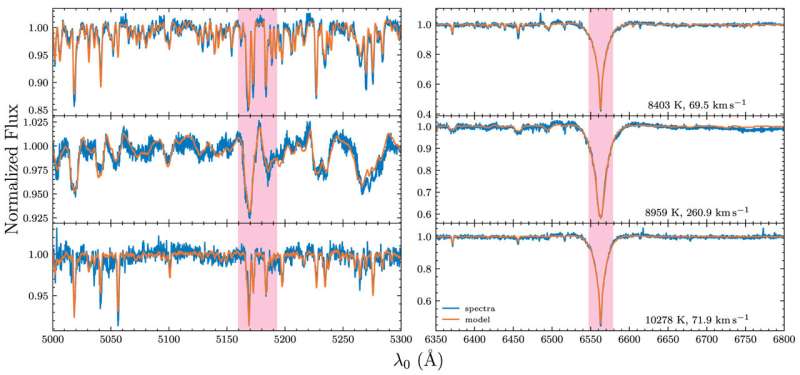LAMOST reveals secret of stellar rotation of hot stars

Stars all rotate, but at different rates. Stellar rotation profoundly affects almost every aspect of stellar evolution. But the evolution of the angular momentum remains a mystery.
A new study led by Ph.D. candidate Sun Weijia from Peking University and the National Astronomical Observatories of Chinese Academy of Sciences (NAOC) provides a fresh comprehension of their rotation behavior by studying the rotational velocity of hundreds of thousands of massive stars.
Related results were published in The Astrophysical Journal Supplement Series and The Astrophysical Journal.
The Sun has a mean rotational velocity of about 2 km/s at its equator, while more massive stars can reach a rotational velocity of hundreds of km/s. Such a vast difference poses fundamental questions about the origin and the evolution of these fast rotators' angular momentum.
"Fast rotation is ubiquitous among massive stars," said Sun Weijia, the leading author of this series of studies. "Our study provides clues for understanding how the angular momentum of massive stars evolves during the majority of its lifetime."
To investigate their rotational behavior, the researchers used data from the latest survey based on the Large Sky Area Multi-Object Fiber Spectroscopic Telescope (LAMOST), which is spectroscopically observing tens of millions of stars.
By using a novel data-driven method, they obtained the stellar properties of over 40,000 massive stars, which paves the way for reviewing the properties of stellar rotation distributions to unprecedented accuracy and details.
"Such a catalog will reform our understanding of massive star evolution," he said. "Our data challenges the idea that stars with peculiar chemical abundance are all slow rotators."
Moreover, these works reveal the detailed structure of how rotation rates vary as a function of stellar mass and metallicity.
The complicated rotation map reveals the inner environment of hot stars, composed of radiative envelop and convective core. Its dependence on metallicity will help us understand the chemical enrichment history of our Milky Way and the contribution of rotation on the oldest stars in the cosmos.
More information: Weijia Sun et al, Exploring the Stellar Rotation of Early-type Stars in the LAMOST Medium-resolution Survey. I. Catalog, The Astrophysical Journal Supplement Series (2021). DOI: 10.3847/1538-4365/ac1acf
Weijia Sun et al, Exploring the Stellar Rotation of Early-type Stars in the LAMOST Medium-resolution Survey. II. Statistics, The Astrophysical Journal (2021). DOI: 10.3847/1538-4357/ac1ad0
Journal information: Astrophysical Journal
Provided by Chinese Academy of Sciences




















